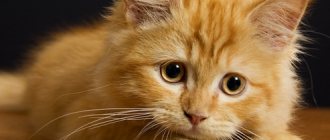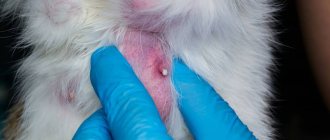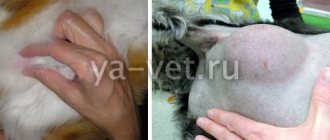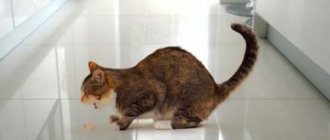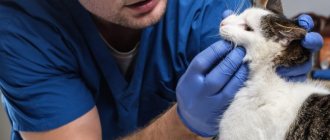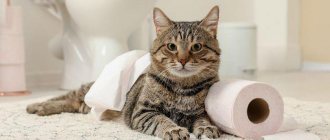Diseases that cause a cat's nose to peel off are varied: fungal infection, skin parasites, allergic reaction, skin injury. The condition may be accompanied by itching, the appearance of scales and crusts, and hair loss around the nasal mucosa. At the first symptoms, your pet should be shown to a veterinarian, who will prescribe therapy based on the examination results.
According to veterinarians, flaking of the nose or the appearance of discharge may signal dangerous feline infections - rhinotracheitis or calcivirosis.
Why does a cat go bald: reasons
Baldness (alopecia) leads to the appearance of bare patches of skin on your pet's body.
If there is too much hair, bald spots appear, the animal behaves restlessly
The main reasons for the development of pathology:
- allergic reaction;
- damage by fleas, lice;
- the presence of a scabies parasite;
- otodectosis (ear mites);
- fungal or lichen infections (dermatomycosis, dermatophytosis);
- pyoderma;
- purulent formations on the skin;
- oily seborrhea;
- deficiency or excess of thyroid hormones;
- increased work of the adrenal glands;
- diabetes;
- genetic predisposition;
- stress;
- lack of vitamins;
- chronic diseases of internal organs.
Important! A common cause of alopecia is food allergies. It is not recommended to give pets food from the human table. Veterinarians advise buying specialized food that contains the necessary vitamins and minerals.
Wounds and allergies
Sores and crusts on a cat's nose and around the lips may be the result of an allergic reaction. Typically, such symptoms appear in response to food allergens, but damage to the skin of the nose can be caused by contact with household chemicals.
For treatment, special antihistamine drops are used. You can buy them at a veterinary pharmacy. If the allergic reaction is moderate, it is enough to eliminate the irritant for the symptoms to subside. No specific treatment is required; it is enough to avoid contact with the allergen in the future and treat the crusts with an antiseptic to prevent infection.
Diagnosis of alopecia in different parts of the body
Only a doctor can determine why a cat is going bald. The basis of diagnosis includes medical history, visual examination, and microscopic examination of hair roots.
The pet's blood is examined and a scraping is taken from the skin. If a tumor is suspected, an x-ray or ultrasound is performed.
The diagnosis is partially helped by the localization of bald spots on a cat:
- Symmetrical baldness of the abdomen, thighs, sides, and front legs is a characteristic symptom of a skin disease.
- Due to stress, cats tear out hairs in the anus , on the back, paws, stomach, and inner thighs. This happens especially often in the following breeds: Siamese, Abyssinian, Himalayan.
- Hormonal disorders are usually indicated by alopecia on the bridge of the nose , base of the tail, hips, and chest. The skin ceases to be elastic.
- In the case of a lack of thyroid hormones, pet hair is easily pulled out in the pelvic area , on the stomach, chest and neck.
- Cancerous formations provoke bald spots on the stomach, chest, and paws . Oncology can cause complete hair loss.
- Vitamin deficiency is characterized by the appearance of small, round bald patches, which can unite. The skin in places where there is no fur is bright pink.
- Fungal infections are characterized by the appearance of bald spots with scaly, cracked skin.
Scratching a pet's skin is dangerous due to infection and the development of an inflammatory process.
To make it easier for you to determine the cause of your pet's baldness, we have prepared a table. It contains all the main pathologies accompanied by hair loss in a cat:
Infections
Heavy nasal discharge in a cat is often a symptom of infection. The fluid may be thick, clear or cloudy, flowing only after physical activity or all the time. Drainage during infections is usually bilateral, that is, the cat's nose runs from both nostrils at once. Usually, at the beginning of the disease, the liquid is watery and transparent, and as the disease develops, the cat’s nasal discharge becomes thick, foul-smelling, opaque and colored - yellowish, pinkish, swampy, etc. Heterogeneous greenish-gray discharge is pus from the cat’s nose, formed due to increased activity of pyogenic microbes. You should consult a doctor immediately, especially if symptoms include coughing and sneezing, high fever, inflammation of the mucous membranes, refusal to eat, and apathy. Many viruses are deadly, and delay is unjustifiably risky. Before visiting a veterinarian, you should not use any nasal drops for cats, as a symptomatic remedy will complicate the diagnosis. To facilitate the breathing process, the discharge is removed with a damp swab.
In addition to viruses, your cat's nasal discharge may become worse due to a bacterial or fungal infection. As a rule, illnesses of this kind indicate a decrease in immunity, which is fraught with more serious diseases. Fungus on a cat's nose may seem harmless - appetite is preserved, activity is normal. But this is a deceptive calm before the “storm”, so consultation with a veterinarian is necessary. Bacteria - cocci, etc. - also pose a serious danger due to immune suppression. If a cat’s nose is peeling, the color of the nose or the fur on its face suddenly changes, or strange crusts, dots, or spots appear on the nose, be sure to do an analysis to identify fungi/bacteria (culture).
When a sore on a cat’s nose does not heal for a long time, infection with bacteria or fungi is also suspected. In this case, the veterinarian will prescribe an ointment containing an antibiotic. Sometimes it is necessary to open the wound to remove accumulated fluid. Pus from the nose of a cat suffering from a bacterial or fungal infection of the nasopharynx indicates a worsening of the condition - the veterinarian will prescribe an intramuscular antibiotic, restorative and, possibly, immunostimulating drugs.
How to treat baldness, what to do, how to help at home?
Therapy for the disease is aimed at eliminating the causes of alopecia:
- For allergies, contact with the allergen is eliminated, the use of anti-allergy drugs, immunostimulants, and diet are effective.
- For parasitic lesions, shampoo, ointment, and spray are prescribed.
- Pyoderma and abscesses are eliminated by excision of the affected skin, antibiotics and antiseptics are used to treat wounds.
- Stressful conditions are corrected by taking sedatives.
- Malfunctions of the thyroid gland are treated with hormonal medications; if a tumor develops, surgery is prescribed.
- Bacterial folliculitis is treated with antibiotics, usually amoxicillin. The pet is washed with medicated shampoo.
- For ringworm, the hair needs to be cut, Ketoconazole, Itraconazole, Griseofulvin are taken orally.
Important! Bald spots in cats caused by hereditary causes cannot be treated.
Wounds
A scratch, bite, laceration on a cat’s nose and any other injury that breaks the skin is an entry point for billions of pathogenic microbes. To stop bleeding, the wound is blotted with a gauze swab soaked in 3% hydrogen peroxide. After a few minutes, the edges of the wound are treated with brilliant green or a healing ointment (for example,). The treatment is repeated until complete healing. If a sore on your cat’s nose does not go away within three days or an abscess forms at the site of the wound, you should consult a veterinarian.
Baldness in cats, how to deal with shedding: advice from a veterinarian
Seasonal shedding is normal. This period is especially noticeable for owners of long-haired pets. Molting can last from 2 weeks to 3 months. Veterinarians advise washing and combing animals more often during this time.
Effective shampoos against hair loss:
- "Phytoelite" from "Veda";
- SynergyLabs Shed-X Cat;
- Perfect Coat 8 in 1.
It is useful to take vitamin complexes, preferably in liquid form.
Bald spots in cats caused by hereditary causes cannot be treated.
To remove hair from the stomach, it is recommended to give special medications:
- Pet Naturals of Vermont;
- Actipet;
- Vaseline oil, etc.
Ordinary grass can help get rid of lumps; in the summer, it is enough for the animal to go for a walk; in winter, the seeds can be purchased at pet stores and planted yourself.
If shedding is accompanied by specific signs, it is necessary to show the cat to a doctor.
Preventing hair loss in cats
To protect your pet from the unpleasant symptoms of hair loss, owners need to follow several rules:
- Provide your cat with a balanced diet.
- Avoid factors that provoke stress.
- Vaccinate against infectious diseases on time.
- Avoid contact between a healthy animal and a sick one.
- Treat wool promptly when parasites appear.
- Carry out preventive examinations regularly.
Infectious diseases
If a cat has black crusts on his nose that do not heal for a long time, the cause should be sought in infectious diseases. Associated symptoms of infectious diseases:
- Nasal discharge.
- Otitis.
- Lethargy.
- Increased sleepiness.
In this case, the animal may refuse to eat and be lethargic. Particularly severe forms of infectious diseases are accompanied by vomiting and dehydration.
Cat infections are very dangerous, especially if the animal does not have all the necessary vaccinations. Black crusts on the nose are one of the most harmless symptoms; in severe cases, infectious diseases can lead to the death of the pet. You cannot try to cure the cat yourself; you should take the animal to a veterinary clinic. This may require long-term hospital treatment.
What to do if your pet's hair falls out to bald spots?
The table provides general information about what diagnostic procedures are performed for feline alopecia:
| Diagnostic procedures | Purpose of the event | |
| Laboratory | Blood analysis | Assessing the condition of internal organs, identifying inflammatory processes in the body, studying the process of hormone production. |
| Instrumental | Ultrasound | Determination of the condition of internal organs, detection of damage to them by cancer cells. |
| X-ray | ||
| Hair research | Identification and identification of the type of ectoparasites. | |
| Application of Wood's lamp | ||
| Scraping the affected skin | ||
Treatment depends on the specific cause that led to your cat's receding hairline. General information about treatment methods for feline alopecia is presented in the table:
| Cause of alopecia | Treatment approach | Drugs | |
| Allergy | Conservative | Antihistamines | Zodak, Zyrtek, Tavegil |
| Stress | Sedatives | Drops "Bayun", "Stop-stress", "Fitex" | |
| Damage by ectoparasites | Antiparasitic | Advantage, Lawyer | |
| Skin infections | Antibacterial | Amoxicillin | |
| Fungal infection | Antifungal | Itraconazole, Ketoconazole, Griseofulfin | |
| Hormonal imbalance, hyperplasia | Surgical | Castration | |
| Cancer | Tumor excision | ||
If there is cat hair lying all over your apartment, you need to take emergency measures. Perhaps the cat is sick. Hair loss can be caused by various reasons.
Why does a cat go bald - reasons
01. The first reason is not at all terrible: it may be physiological reasons or seasonal changes in fur in especially fluffy individuals.
02. The second reason is adenitis. Most often it affects male cats. It appears as follows:
- crusts appear on the head and ears;
- the fur can be pulled out without causing pain or harm to the cat.
Since this disease is extremely rare, it is better to visit a veterinarian so that he can make an accurate diagnosis and prescribe treatment. While the case is pending, you can purchase a special detergent or shampoo.
03. The third reason is food allergies. Digestion in cats and cats occurs in a special way. Allergies can occur from any product.
Therefore, you should remember that you cannot share your food with your cat. It is better for her to purchase balanced food, with the necessary vitamins and supplements.
If circumstances force you to change food, it needs to be checked for the degree of digestibility, giving the pet a small amount. Read about how and what to feed your cat here.
04. The fourth reason may be injection. The fur will begin to fall off at the injection site. Gradually everything will fall into place; in this case there is no need to treat hair loss.
05. The fifth reason is seborrhea. Because of it, your furry friend suffers from peeling skin and spreads an unpleasant odor. You will have to have your blood tested at the veterinary hospital. Your veterinarian will recommend shampoo and fatty acids.
06. The sixth reason is lichen. To avoid this disease, you need to keep your cat clean. Well, if this happens, the doctor will prescribe medications.
07. The seventh reason is infestation with fleas or lice. It’s easy to get rid of them by using special hygiene products, but you should monitor your cat more carefully.
08. The eighth reason can be considered stress. When can a cat get it? Due to their personality traits, some animals may begin to go bald from stress during moving, changing housing, or participating in an exhibition. The cat is going bald on the hips, abdomen, and inner sides of the paws.
At this time, the pet needs increased attention and care. In addition, you should distract the animal from the constant desire to lick its fur, because in this case this procedure only provokes its loss.
09. The ninth reason is hormonal imbalance. Spayed or neutered animals may go bald due to hormonal imbalance. The cat behaves calmly. Treatment of baldness from this cause will be associated with taking hormonal medications, again prescribed by a doctor. The fur will be restored completely.
Calcivirosis
If a black crust suddenly appears on your cat’s nose, you should take a close look at the animal’s behavior. One of the dangerous cat diseases is calcivirosis. Animals are usually vaccinated against this disease, but street cats that accidentally enter the house may not be vaccinated. Symptoms of calcivirosis:
- wounds and crusts on the mucous membranes of the mouth, ears and nose;
- conjunctivitis and tearing eyes;
- damage to the paw joints;
- increased body temperature;
- swollen lymph nodes;
- labored breathing.
To treat calcivirosis, you should consult your doctor about the use of medications. There is no universal treatment regimen for this disease; therapy is selected depending on the symptoms and age of the pet.
Crusts on the nose should be lubricated with chlorhexidine or Lugol's solution twice a day. To make breathing easier, the nasal passages must be treated with special drops.
Preventing hair loss in cats
- It is necessary to understand that proper care of your furry pet, proper feeding, providing it with vitamins - all this will serve to prevent any diseases, including hair loss.
- It is necessary to regularly treat the animal for parasites, and also regularly conduct examinations by a veterinarian.
- By regularly examining the animal yourself, you can also determine whether there is cause for alarm by detecting the onset of baldness. With some fungal diseases, you can become infected yourself.
These measures, of course, will not be able to completely eliminate the risk of disease, but they will significantly reduce the likelihood of their occurrence.
Having settled a cute and furry friend next to you, do not forget that he needs care, to which there will always be a grateful response that will bring joy and happiness to the house.



